Citrix Sharefile has long been a popular choice in the world of digital document management.
The platform provides a secure way to store files, share them safely, and use them to collaborate with external, third parties.
In 2023, Sharefile also received a major upgrade when Citrix consolidated its electronic signature product, RightSignature, into the Sharefile platform.
While this move brings new functionality to Sharefile, it also increases the complexity and adds to the potential performance issues that Sharefile has seen in the past.
And, while adding e-signing does make Sharefile more competitive, it’s not the only platform on the market that offers such functionality.
In this article, we’ll see how Sharefile compares to similar storage/signing platforms.
Let’s get started!

Why switch from Sharefile?
There are a lot of reasons to love Sharefile.
That’s especially true if you’ve been with them for an extended length of time and have integrated your file system with the platform.
However, there are a few reasons that you might consider switching.
Digital signatures are only available with Sharefile Premium and above.
When Sharefile consolidated RightSignature into the platform, it did so by adding e-signature functionality to its Premium and Virtual Data room plans.
Users on lower-tier plans (Standard, Advanced) won’t have access to this feature set and will need to seek support from other signing platforms (or upgrade) in order to digitally sign documents.
While the most straightforward solution is to simply upgrade, the minimum cost for this is roughly $27 per month — moving from the Advanced plan to the Premium plan on an annual subscription.
Any other upgrades will incur higher costs.
While it’s possible to find budget-friendly e-signature solutions for lower costs (check out our DocuSign alternatives article for a few ideas), this approach becomes problematic because of the Sharefile export process and its limited integration options (see below).
Ultimately, relying on an alternative solution will create several manual processes that can’t be easily automated.
For teams seeking to maximize efficiency, that’s a major setback.
Limited integration options when compared to competitors.
The ability to integrate with other apps in the corporate tech stack is essential for businesses of all sizes.
Unfortunately, when compared to other storage/digital signature solutions, Sharefile falls short on integrations.
While the platform carries integrations with some CRM tools, even these are severely restricted by plan and use case.
For example, users seeking an integration with Salesforce will need to purchase Sharefile Premium.
This integration isn’t available with the Standard or Advanced Plan.
The integration is also unavailable on the more expensive Virtual Data Room plan.
By comparison, Dropbox also includes a built-in e-signing solution and is known for its robust integration options.
If connecting your document storage and e-signing tools with your CRM and other productivity, there may be other platforms out there that better fit your needs.
Minimum seating requirements create high costs for smaller teams.
All Sharefile plans require a minimum of three users.
If you have the headcount to fill those seats, the Sharefile platform is competitive with or better-priced than many other document storage platforms.
Headcounts can also be scaled up easily to accommodate larger enterprises.
On the other hand, if you’re a small business without the minimum headcount, you’ll end up paying more per user than you would on many other platforms because of that empty seat.
While Sharefile offers a broad range of features, alternative solutions and competitors can offer similar solutions at a lower cost.
1. Dropbox
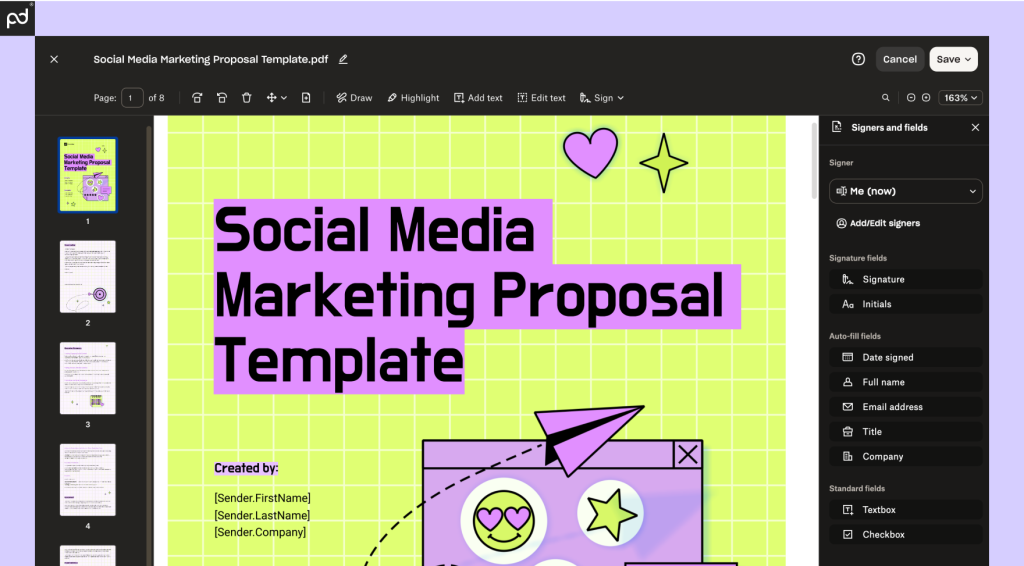
Cost: Essentials ($16.50); Business ($45); Business Plus ($72). Enterprise pricing also available. Pricing based on annual subscription. All plans above Essentials require three users.
Best for: Businesses of all sizes who need large storage capacity, file access control, and e-signing.
Support options: Email; chat; knowledge base; phone support (some plans).
Free trial: Yes; 30 days.
In the world of file storage, Dropbox is a household name. The company was first founded in 2007 and has seen tremendous growth since then.
These days, Dropbox handles files for everyone from private users to major, international corporations.
But, while this brand is most known for its robust file storage solutions, Dropbox’s business plans also offer a great selection of features around e-signing, integrations, and user controls.
Here’s a closer look a few notable features:
- Huge (and growing) storage capacity. Dropbox offers a huge storage capacity for each of its plans, and that storage capacity increases as the company aims to keep its plans competitive.
- Unlimited signature requests. Unlike DocuSign and similar e-signing solutions, Dropbox doesn’t cap the number of signature requests for your documents. Send as many documents as necessary from within the Dropbox platform.
- Account management and compliance tools. Higher-tier plans (Business and above) get access to team management consoles, HIPAA compliance options, and granular access permissions.
It’s also worth pointing out that Dropbox also offers Dropbox Sign (formerly HelloSign) as a no-storage electronic signature solution.
This is a great solution if you’re looking for more advanced-signing tools (bulk sending, advanced approvals, etc.).
Dropbox Sign plans are separate from the standard business plans and come with their own set of features.
2. PandaDoc

Cost: Essentials ($19); Business ($49). Essentials caps at two seats. Enterprise pricing also available.
Best for: Teams who want to consolidate document creation and e-signing processes.
Support options: Email; 24/7/365 live chat; knowledge base. Premium support options available.
Free trial: Yes; 14 days.
When compared to Sharefile or Dropbox, PandaDoc feels like more of a niche solution.
This platform is designed primarily to consolidate and manage all aspects of your sales workflow.
You won’t find an endless storage repository here, as you would with Dropbox.
Instead, PandaDoc is equipped with unparalleled document editing and customization options, as well as a huge collection of sales automation tools to help users sign contracts, close deals, and move business along.
Here’s what to expect from PandaDoc:
- From-scratch document creation. Using the in-app editor, PandaDoc users can create documents entirely from scratch or import DOCX files as a starting point. Templates, a dedicated content library, and a product catalog can also expedite future document generation projects.
- Unlimited document storage. PandaDoc provides unlimited storage solutions for all documents uploaded to the PandaDoc platform. Multimedia can also be hosted in the content library for insertion in sales documents.
- 24/7/365 support. PandaDoc is one of the few brands to offer around-the-clock, human-powered support. Whether you’re a large enterprise or a solo user, PandaDoc Support is always on standby to help you resolve issues and get back to work.
Unlike Sharefile and most of its competitors, PandaDoc is a complete solution that accommodates every aspect of the sales process.
You’ll find a host of integration options for various CRMs (Salesforce, HubSpot, etc.) and other document creation tools (Google Drive, Microsoft Word, etc.).
Combined with dedicated mobile apps, a user-friendly interface, and great document tracking tools, PandaDoc is a great option for everything from document creation to contract management.
Don’t believe us? Try it out for yourself right here.
3. Adobe Acrobat Sign
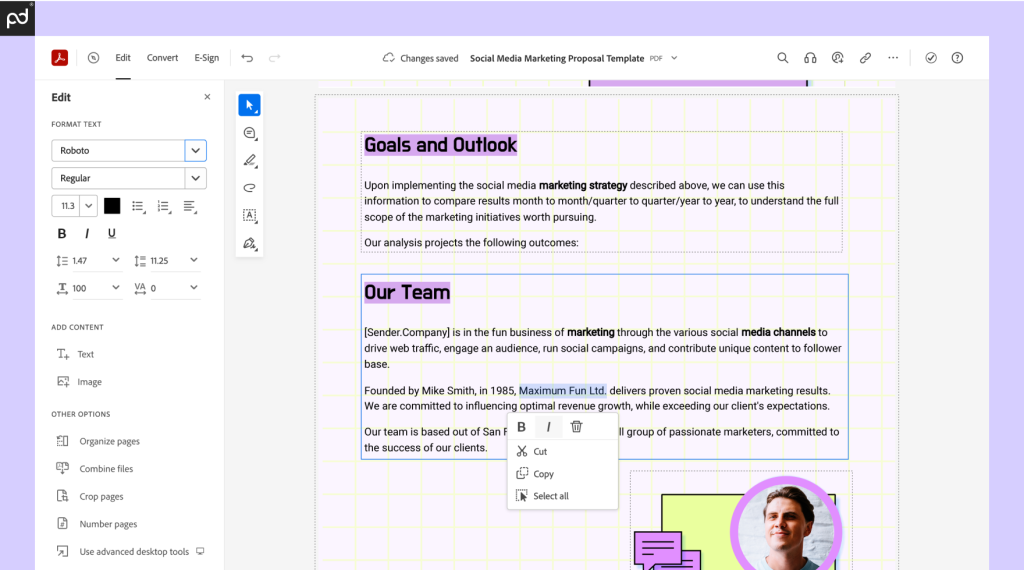
Cost: Acrobat Standard ($13); Acrobat Pro ($20); Acrobat Standard for teams ($15); Acrobat Pro for teams ($24). All pricing based on annual commitment. Enterprise solutions available.
Best for: Companies working primarily with PDF documents.
Support options: Knowledge base; support tickets; live chat; additional support plans sold as separate packages.
Free trial: Yes; 30 days.
Adobe Acrobat Sign positions itself as an e-signature software poised as a DocuSign competitor.
However, the platform has far more to offer than digital signature capture.
Adobe has combined Acrobat Sign with Adobe Reader and Document Cloud, giving users the ability to edit PDFs as if they were native documents and store them in its cloud-based service.
All of this is bundled into a single package, so you’ll have access to these tools with any Adobe Sign subscription.
Here’s a closer look at a few key features:
- PDF editing support. Thanks to Adobe Reader, included with every Acrobat Sign subscription, users will be able to edit and modify uploaded PDFs as if these documents were still in their native format.
- Seamless handoff between desktop and mobile. Document Cloud manages syncing between all devices. Acrobat Sign users will be able to upload documents and hand them off seamlessly between a variety of apps while ensuring that data remains protected.
- Microsoft 365 integrations. Although Acrobat Sign does offer additional integration options at the enterprise level, Microsoft 365 integrations are available for all plans and tiers.
While Sharefile positions itself as a document management and storage solution with e-signing as a secondary feature, Acrobat Sign does nearly the opposite.
This platform is heavily engaged in the document signing process and aims to help organizations streamline its document and signature workflows with a handful of tools.
One major drawback to consider when using this platform is the transaction limits attached to its plans. Acrobat Sign limits its business plans to 150 transactions per year.
This cap can be raised by talking to the sales team, but doing so will incur an additional plan cost.
For power users intended to send documents, alternative signing solutions like PandaDoc or Dropbox may be a better fit.
Want to know more? Read our full review of Acrobat Sign.
4. Box
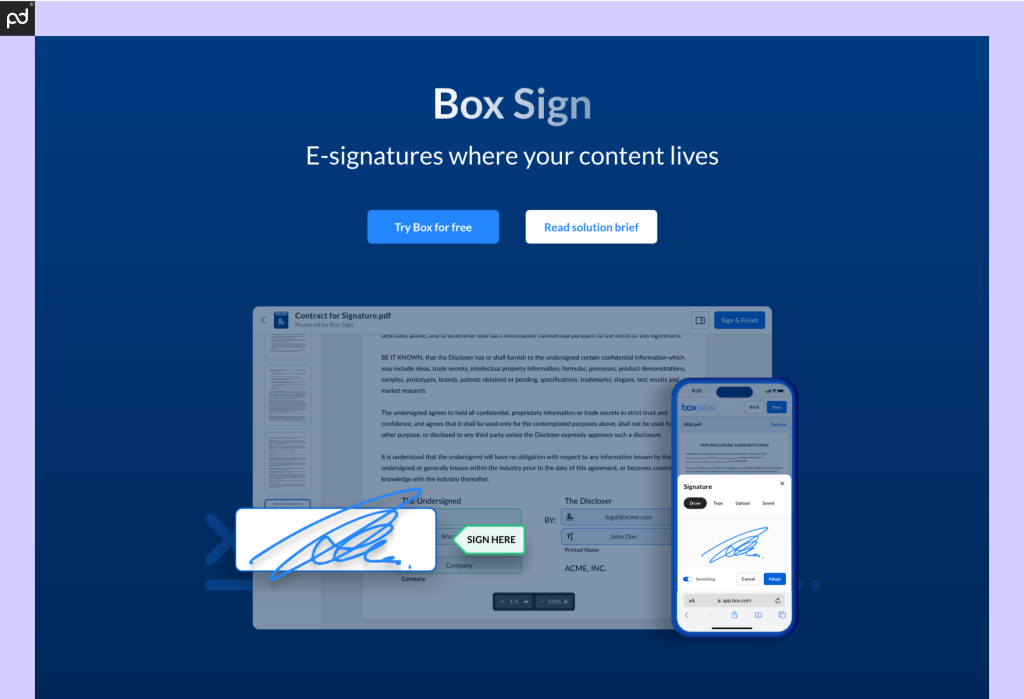
Cost: Business Starter ($15); Business ($45); Business Plus ($75); Enterprise ($105). Pricing based on annual commitment. All business plans require a three-seat minimum. Personal and custom plans also available.
Best for: Teams looking for a great mix of integrations, collaboration tools, and document storage.
Support options: Email; live chat; knowledge base; phone support (some plans).
Free trial: Yes; 14 days.
A comprehensive content management and collaboration platform, Box provides a centralized hub for businesses to store, manage, share, and collaborate on files in a secure way.
However, Box offers more than just file storage and sharing.
Through its Box Sign feature (built by the same group that created SignRequest), this platform also provides a robust e-signature solution, making it a direct competitor to platforms like Sharefile and DocuSign.
Here’s a closer look at a few key features:
- Secure cloud storage. Box offers enterprise-grade security with features like data encryption, access controls, and compliance certifications, ensuring your files are protected.
- Collaboration tools. Box enables seamless, real-time collaboration with a Box Canvas, allowing users to create whiteboards and mapping together. Teams can also add comments, co-edit documents, and more.
- API Calls. Every Box business plan offers API access that developers can use to integrate Box functionality with other applications. The Business Starter plan offers 25,000 calls per month, and that number increases on higher-tier plans.
Box also provides unlimited e-signing for documents signed via its web app.
However, signatures acquired via third party and custom integrations are limited by plan (usually between 100 and 250 per year).
This is something to keep in mind if you want to take advantage of Box Sign but you don’t plan to do so on the Box signature platform.
Especially when compared to Sharefile, Box offers a great way to streamline business processes, manage docs, and acquire digital signatures.
Similar to Dropbox, the platform also offers a huge selection of integrations (including an integration with PandaDoc!), allowing users to integrate with their workspace in ways that Sharefile simply doesn’t offer.
5. Egnyte
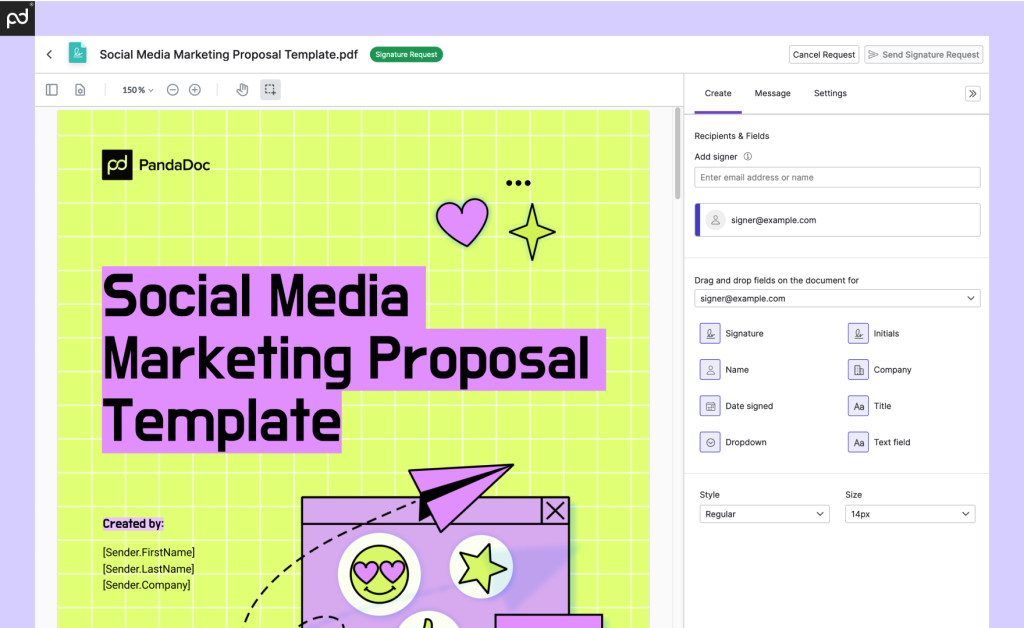
Cost: Team ($10); Business ($20); Enterprise Lite ($35). Pricing based on annual commitment. Enterprise pricing also available.
Best for: Tech savvy teams seeking collaborative document storage solutions
Support options: Email; knowledge base; phone support (some plans).
Free trial: Yes; 15 days.
Egnyte positions itself as a unified content security and governance platform, combining robust file sharing and collaboration features with advanced security, compliance, and data governance capabilities.
This makes it a comprehensive solution for businesses seeking to protect their sensitive information while enabling efficient collaboration.
The platform is modular. At its core, Egnyte acts as a file server where documents can be stored and accessed.
However, when using its extensive library of add-ons and connectors, it’s possible to increase functionality to include document editing, e-signing, and more.
Here’s a closer look at some key features:
- Secure file sharing and storage. Egnyte provides a secure environment for storing, sharing, and accessing files, both on-premises and in the cloud. It offers granular access controls, encryption, and data loss prevention features to safeguard your sensitive data.
- Collaboration tools. Egnyte enables seamless collaboration with real-time co-editing, commenting, version control, and approval workflows, streamlining content creation and review processes.
- Content governance. Egnyte offers comprehensive content governance capabilities, including data classification, retention policies, legal holds, and eDiscovery, helping you manage your information lifecycle and meet regulatory requirements.
Egnyte’s authentication and security processes are a big plus for teams handling secure documents.
At the same time, signers engaging with the platform won’t have to endure additional hardship during the authentication and validation process prior to signing or collaborating.
However, one key difference we noticed between this tool and most other platforms we tried was its cumbersome setup.
Many features around PDF editing and signing weren’t enabled by default during our testing, and onboarding was rough.
If Egnyte seems like a good fit, be prepared for an extended setup process (and a few headaches) as you get started.
6. Tresorit
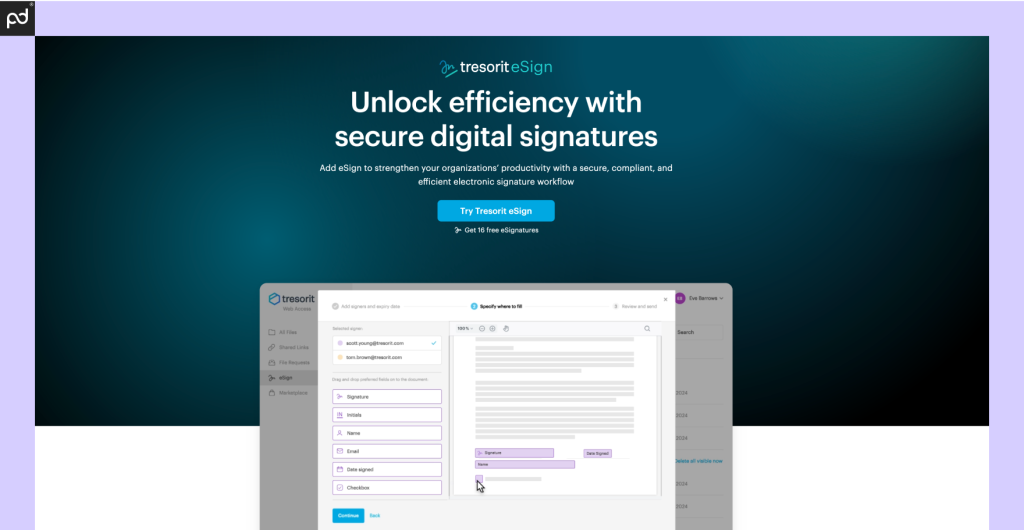
Cost: Professional ($27.49); Business ($57). Pricing based on annual commitment. Business plan requires three-seat minimum. Enterprise pricing also available.
Best for: Security conscious teams who need a strong mix of document security and e-signing.
Support options: Email; live chat; knowledge base; phone support (some plans).
Free trial: Yes; 14 days.
While Sharefile brands itself as a storage and collaboration tool with security features and access control, Tresorit prioritizes security and privacy above all else.
The platform offers a comprehensive suite of tools for securely storing, sharing, and collaborating on documents, with a strong emphasis on protecting sensitive information.
Here’s what to expect with Tresorit:
- Zero-Knowledge encryption. Tresorit employs zero-knowledge encryption, ensuring that only you and authorized recipients can access your files. Even Tresorit itself cannot access your data.
- Considerable storage capacity. Tresorit’s Professional plan (single-user) offers 4TB of storage and a maximum file upload size of 100GB, which places it in line with Dropbox and similar competitors.
- Limited e-signing functionality. By default, Tresorit only offers around 10 signatures per month. A separate add-on can be purchased to increase this amount and provide advanced functionality, such as signing orders, e-signing without a Tresorit account, and fillable fields.
Despite Tresorit’s limited e-signing functionality (without the add-on), this platform is one of the few options on our list for individuals seeking eIDAS-complaint qualified electronic signatures (QES).
These signatures are difficult to acquire due to the physical hardware component required for their acquisition.
From a compliance standpoint, Tersorit provides a signature solution that meets all EU regulatory requirements.
However, signers will be responsible for acquiring their own qualified hardware to facilitate QES acquisition.
7. GetAccept
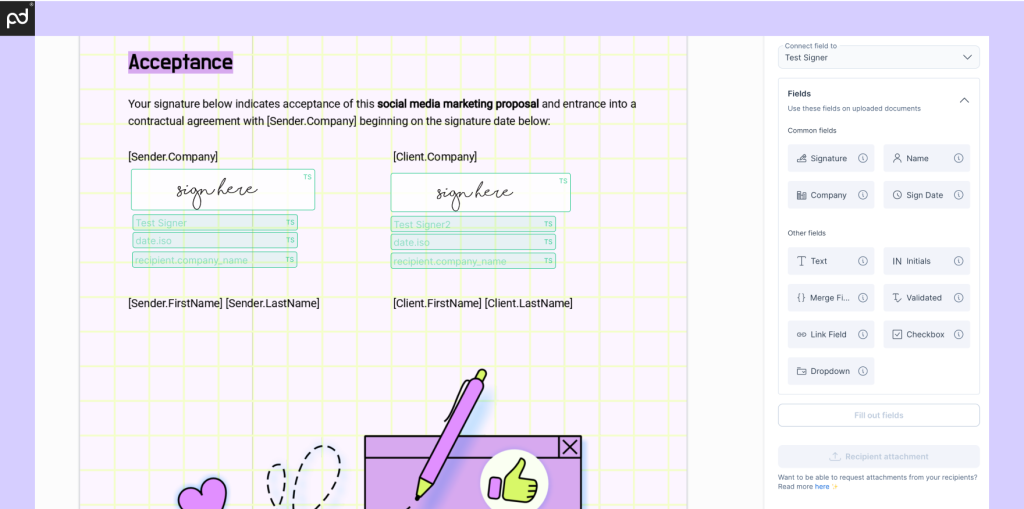
Cost: eSign ($25); Deal Room ($39); Contract Room ($49); Full Suite ($79). Pricing is month-to-month. Enterprise options also available.
Best for: Sales teams seeking a combination of document management, e-signing, and virtual sales tools.
Support: Knowledge base; live chat support.
Free trial: Yes; 14 days.
GetAccept is a comprehensive sales enablement platform designed to streamline and optimize the sales process from proposal to close.
As it’s more than just an e-signature tool, this platform aims to empower sales teams with a suite of features to create, send, track, and e-sign documents, while fostering engagement and collaboration with prospects.
By combining document creation, notifications and tracking, e-signatures, and communication tools into a single platform, GetAccept helps sales professionals close deals faster and more efficiently.
It’s a popular choice among businesses looking to enhance their sales performance and improve customer engagement.
Here’s a closer look at some of GetAccept’s key features:
- Document create and tracking. Easily create professional-looking proposals, contracts, and other sales documents with customizable templates. Get real-time insights into document interactions, including when recipients open, view, and engage with your documents.
- E-Signatures capture. Collect legally binding e-signatures electronically, streamlining the closing process and reducing the need for paper-based contracts.
- Communication and engagement tools. Engage with prospects through live chat, video calls, and comments directly within the documents, fostering stronger relationships and driving deals forward.
Compared with Sharefile, GetAccept is a little lighter on the document storage and more heavily focused on sales enablement.
Similar to PandaDoc, GetAccept users can still store plenty of documents and multimedia on the GetAccept platform.
However, the focus is angled toward proposal and sales rather than having the platform function purely as a document repository.
At the same time, GetAccept goes far beyond Sharefile by providing plenty of tools to enhance the sales process.
Plus, its emphasis on document analytics and tracking (more than just audit trails) will differentiate it as a powerful platform for teams who want to streamline sales workflows.
Want to learn more? Check out our full review of GetAccept.
Other storage & e-signing solutions
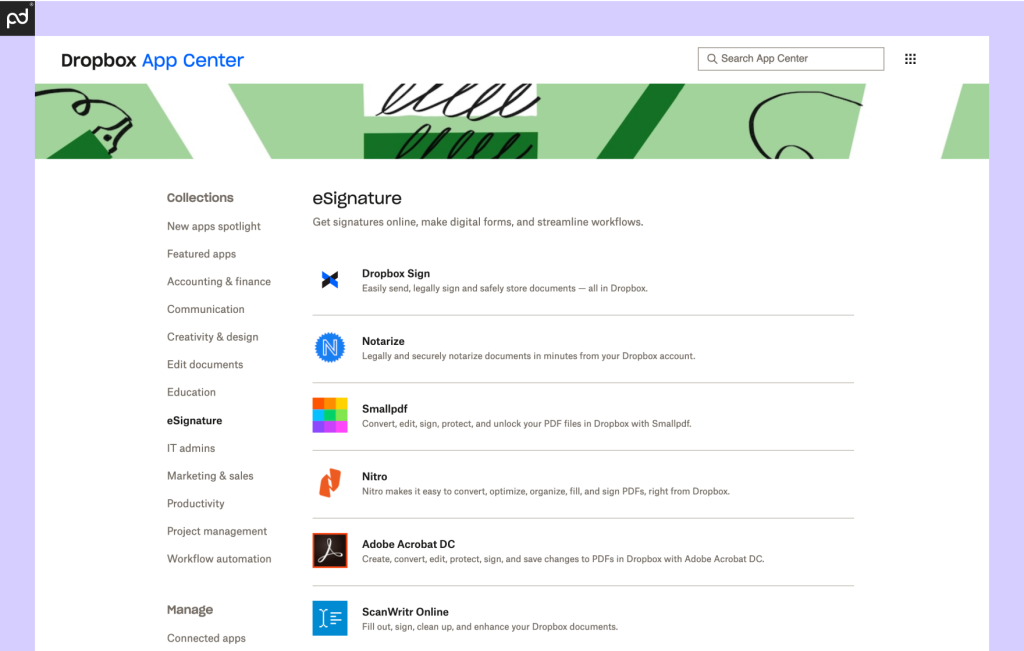
So far, we’ve mentioned turnkey solutions that will allow functionality similar to Sharepoint.
While several platforms offer built-in storage and e-signature capabilities, it’s also possible to replicate ShareFile’s functionality by combining separate tools.
This modular approach allows for greater flexibility and customization, potentially catering to specific needs or preferences.
The core concept is to choose a robust document repository or cloud storage solution that aligns with your requirements for file management, organization, and access controls.
Popular options include:
- Google Drive for Business. Offers ample storage space, collaboration features, and integration capabilities.
- Dropbox Business. Provides secure cloud storage, file sharing, and version control.
- Microsoft OneDrive (or SharePoint). Ideal for enterprise-level document management and collaboration.
Once you’ve selected your preferred document repository, you can integrate it with a third-party e-signature solution like DocuSign or SignNow.
Users can also link these repository tools to platforms like PandaDoc, Formstack, or GetAccept in order to take advantage of more comprehensive document creation and e-signing workflows.
This approach might be more appealing to businesses that already have a preferred document repository or require specific features in an e-signing solution.
While taking this route will likely require a little more setup, it may be possible to create a more cost-effective and customizable solution than what any single platform can offer.
Our recommendations
If you’re looking to switch from Sharefile, several solutions on our list can make a huge difference in your approach to document storage and e-signing.
Here’s what we’d recommend.
PandaDoc for flexible document creation
ShareFile’s document creation capabilities are relatively basic. If your workflows require a greater degree of document creation, PandaDoc would be a superior solution.
Our platform allows you to create documents from scratch, or with a wide array of templates that you can easily modify to suit your needs.
PandaDoc users can also create conditional fields that only appear if another field is checked, which can be a major advantage when creating documents for various scenarios.
Dropbox for maximum storage capacity
While ShareFile does offer storage capabilities, it’s not necessarily their strong suit.
If you have an enterprise that needs a massive amount of storage space, Dropbox will likely offer a more cost-effective solution.
Dropbox’s simple user interface also makes it easy to find and share files quickly.
Plus, Dropbox integrates with other tools and e-signing platforms.
Using the platform as a document repository means that you’ll still be able to branch out to other solutions for e-signing and contract management.
Acrobat Sign for versatile PDF editing
Like most other e-signing platforms, Sharefile offers some basic PDF editing capabilities. However, these features pale in comparison to Adobe Acrobat Sign’s native PDF editing.
If you need to make more extensive changes to PDF files, such as adding/removing pages, splitting PDFs, or converting file formats, you’ll find the tools within Acrobat Sign to be a much better solution.
From an e-signing perspective, the transaction limits can be frustrating.
On the other hand, the addition of Adobe Reader and Document Cloud means that editing documents and e-signing on mobile devices (Android / iOS) is simple and easy.
Engyte/Tresorit for enterprise-level compliance
While ShareFile does offer some compliance features, Egnyte and Tresorit take it to the next level.
If you have an enterprise that needs to meet strict compliance regulations, these platforms offer a greater degree of security and control over your documents.
Features like data loss prevention, granular access controls, and activity tracking make it easy to maintain compliance with even the most stringent regulations.
These platforms require some additional setup and may need support from tech savvy users at the admin level.
Get started with PandaDoc
Ready to take document creation and e-signing to the next level?
If you’re switching from Sharefile, PandaDoc is a great fit for businesses seeking a more comprehensive, user-friendly, and efficient document management and e-signature solution.
- Create professional documents with an intuitive editor, customizable templates, and extensive content library.
- Streamlines workflows with advanced automation features, allowing for seamless approvals, reminders.
- Collaborate with others using real-time commenting, version control, and in-app communication tools.
PandaDoc easily integrates with popular CRM, payment, and productivity tools, further extending its functionality and streamlining your workflows.
Disclaimer
PandaDoc is not a law firm, or a substitute for an attorney or law firm. This page is not intended to and does not provide legal advice. Should you have legal questions on the validity of e-signatures or digital signatures and the enforceability thereof, please consult with an attorney or law firm. Use of PandaDoc services are governed by our Terms of Use and Privacy Policy.
Originally published September 30, 2021, updated December 12, 2024


